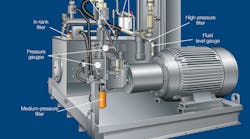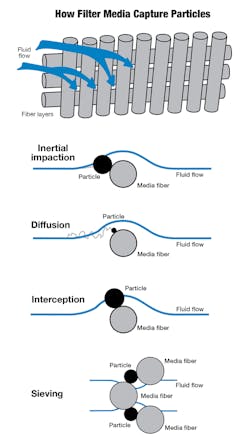The term media is sometimes used to describe a group that is unfriendly to politicians, but in the world of filtration, media describes materials used to capture particles from a fluid flow stream. Filter media must capture particles and also allow fluid to flow through with as little resistance as possible. The dilemma stems from fact that dirt trapped by the media blocks flow paths, so the more particles the media traps, the greater restriction they present to flow. As the fluid flows through the media, it changes direction as it works its way through the maze of media fibers. As the fluid advances through the layers of fibers, it becomes cleaner, but the media becomes cleaner.
How Filter Media Collect Particles
Filter media can capture particles four ways, and usually relies on more than one.
Inertia affects large, heavy particles suspended in the flow stream. These particles are heavier than the fluid surrounding them, so as the fluid changes direction to enter the fiber space, the particle continues in a straight line and collides with the media fibers, where it is trapped and held.
Diffusion works on the smallest particles, which are not held in place by the viscous fluid, so they diffuse within the flow stream. As the particles traverse the flow stream, they collide with the fiber and accumulate.
This drawing illustrates how solid contaminants are captured by filter media. At the top, contaminated fluid flows into the media mat. As different types and size encounter media fibers, they are captured by inertial impaction, diffusion, interception, sieving, or any combination of these. (Courtesy: Donaldson Co.)
Interception works on particles that are not quite large enough to have inertia but not small enough to diffuse within the flow stream. These mid-sized particles follow the flow stream as it bends through the fiber spaces and are captured (intercepted) when they contact a fiber.
Sieving is the most common mechanism in hydraulic filtration and occurs when the particle is too large to pass through the spaces between fibers.
And just as filter media relies on one or more ways to trap particles, they can also rely on one or more materials to accomplish this task. By nature, characteristics of different types of filter media capture particulate contamination (dirt) different ways, and most media use rely on more than one technique. Here are the basic ways media trap dirt.
• Cellulose fibers are wood fibers, microscopic in size and held together by a resin. The fibers are irregular in shape and size. Cellulose often has low beta ratings, which means the media contain smaller pores. Smaller media pores cause greater flow resistance, resulting in higher pressure drop. Although cellulose provides effective filtration for a wide variety of petroleum-based fluids, in certain applications it results in poor filtration performance as compared to synthetic media.
• Synthetic fibers are man-made, smooth, rounded, and provide the least resistance to flow. Their consistent shape allows controlling the size of the fibers and distribution pattern throughout the media mat to create the smoothest, least-inhibited fluid flow. Consist fiber shape allows the maximum amount of contaminant-catching surface area and specific pore size control. The result is media with predictable filtration efficiencies removing specified contaminants and maximum dirt-holding capacity. The low resistance to flow of synthetic media to fluid flow makes it ideal for use with synthetic fluids, water glycols, water/oil emulsions, HWCF and petroleum-based fluids.
Premium synthetic media use glass fibers in a matrix bonded together with an epoxy-based resin system. This material and configuration provide high chemical resistance for a broad array of hydraulic systems.
The chemical and thermal compatibility of fluid filters is an increasingly difficult design challenge due to the complex variety of fluid systems. Today’s hydraulic systems often use fluid tailored to the special needs environmental sensitivity, fire resistance, and electrical insulating ability.
• Wire mesh media consists of stainless steel, epoxy-coated wire mesh available in different mesh sizes to suit the application. Common examples include:
• 100 mesh for 150-µm filtration
• 200 mesh for 74-µm filtration
• 325 mesh for 44-µm filtration
Typically, wire-mesh filters can only capture very large, harsh particles that might otherwise damage a filter element. This media is useful as a coarse filter viscous fluid, such a cold hydraulic fluid upon startup.
Filter media, amount of contamination, the flow rate, and fluid viscosity are all factors in the importance of sizing the filter for the system requirements. Filters that are too small won’t be able to handle the system flow rate and will create excessive pressure drop from the start. The results could be filter operation in the bypass mode, filter failure, component malfunction, or catastrophic system failures. Filters that are too large for the system can be too costly. Oversized filters require more system oil and higher-cost replacement filters.
Media Efficiency per ISO 16889
ISO 16889 is the international standard for Multi-Pass Testing to determine the efficiency (beta beta ratio) and the dirt-holding capacity of the filter. ISO 16889 is the international standard for Multi-Pass Tests to determine the efficiency (beta ratio) and the dirt-holding capacity of the filter. The test apparatus for ISO 16889 must have on-line liquid automatic optical particle counters calibrated using National Institute of Standards & Technology-certified calibration fluid.
The ISO standard requires each filter manufacturer to test a given filter at a variety of flow rates and terminal pressure drop ratings that fit the application, system configuration, and filter size. Users’ actual performance may vary depending on the configuration of the filter tested and test conditions.
Particle counters are calibrated by passing a sample of calibration fluid with a known particle size distribution and producing a calibration curve to match the known count distribution.
Particle counts are taken upstream and downstream of the filter every minute of the test. Beta ratios containing (c) footnote designate NIST traceability.
ISO 16889 recommends reporting beta ratios as rating and efficiency. For example, a rating of 2 represents 50% efficiency; 10 represents 90% efficiency; 100 represents 99%; and 1,000 represents 99.9%.
For example, ß4(c) = 200 signifies that 200 times as many particles 4 µm and larger were counted upstream of the filter than downstream, indicating 99.5% efficiency. Likewise, ß5(c) =1,000 indicates that 1,000 times as many particles 5 µm and larger were counted upstream as opposed to downstream. Downstream represents 99.9% efficiency.
Although filter manufacturers publish beta ratings for filter media to describe efficiency performance levels, a direct connection between the beta rating scale and the ISO rating scale cannot be made. However, manufacturers’ ISO contamination levels are based on controlling the particle counts of 4 µm, 6 µm, and 14 µm particles in hydraulic system oil. This level is identified by measuring the number of particles 4µm and greater, 6 µm and greater, and 14 µm and greater in a 1-ml sample of the system’s hydraulic fluid.
Ultimately, though, the real proof of the performance is how clean the filter keeps the fluid in any given application. A good oil analysis program that checks the cleanliness of the oil periodically will verify that the proper filters are being used.
Information for this article was excerpted from the Fluid Power Handbook & Directory and from filter manufacturers’ published data.
What is Beta Ratio?
Beta ratio (symbolized by ß) is a formula used to calculate the filtration efficiency of a particular fluid filter using base data obtained from multi-pass testing. In a multi-pass test, fluid is continuously injected with a uniform amount of contaminant (ISO medium test dust), then pumped through the filter unit being tested. Filter efficiency is determined by monitoring oil contamination levels upstream and downstream of the test filter at specific times. An automatic particle counter is used to determine the contamination level. Through this process an upstream to downstream particle count ratio is developed, known as the beta ratio. The formula used to calculate the beta ratio is:
ßX = PCU /PCD
Where ßx is beta ratio
X is particle size, µm
PCU is particle count of fluid upstream from filter
PCD is particle count of fluid downstream of filter calibrated with NIST fluid.
For example, ß10(C) = 1,000 indicates that 1,000 more particles 10 µm and larger were counted upstream of the filter than downstream. The (c) indicates that testing was done automatic particle counters



